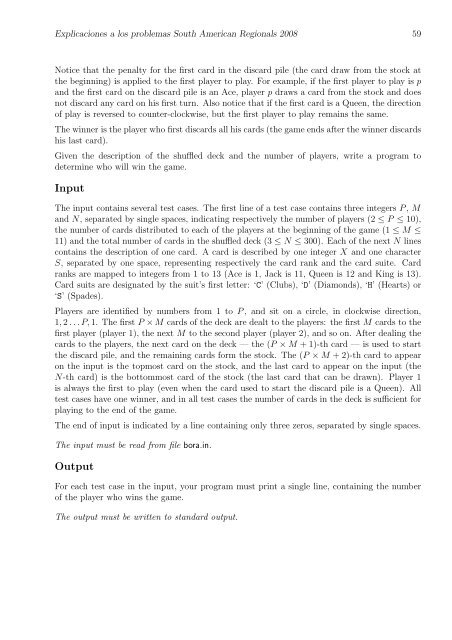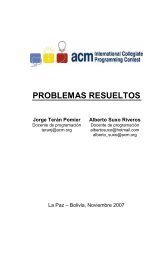Soluciones y Explicación de los problemas ACM ... - ICPC Bolivia
Soluciones y Explicación de los problemas ACM ... - ICPC Bolivia
Soluciones y Explicación de los problemas ACM ... - ICPC Bolivia
Create successful ePaper yourself
Turn your PDF publications into a flip-book with our unique Google optimized e-Paper software.
Explicaciones a <strong>los</strong> <strong>problemas</strong> South American Regionals 2008 59<br />
Notice that the penalty for the first card in the discard pile (the card draw from the stock at<br />
the beginning) is applied to the first player to play. For example, if the first player to play is p<br />
and the first card on the discard pile is an Ace, player p draws a card from the stock and does<br />
not discard any card on his first turn. Also notice that if the first card is a Queen, the direction<br />
of play is reversed to counter-clockwise, but the first player to play remains the same.<br />
The winner is the player who first discards all his cards (the game ends after the winner discards<br />
his last card).<br />
Given the <strong>de</strong>scription of the shuffled <strong>de</strong>ck and the number of players, write a program to<br />
<strong>de</strong>termine who will win the game.<br />
Input<br />
The input contains several test cases. The first line of a test case contains three integers P, M<br />
and N, separated by single spaces, indicating respectively the number of players (2 ≤ P ≤ 10),<br />
the number of cards distributed to each of the players at the beginning of the game (1 ≤ M ≤<br />
11) and the total number of cards in the shuffled <strong>de</strong>ck (3 ≤ N ≤ 300). Each of the next N lines<br />
contains the <strong>de</strong>scription of one card. A card is <strong>de</strong>scribed by one integer X and one character<br />
S, separated by one space, representing respectively the card rank and the card suite. Card<br />
ranks are mapped to integers from 1 to 13 (Ace is 1, Jack is 11, Queen is 12 and King is 13).<br />
Card suits are <strong>de</strong>signated by the suit’s first letter: ‘C’ (Clubs), ‘D’ (Diamonds), ‘H’ (Hearts) or<br />
‘S’ (Spa<strong>de</strong>s).<br />
Players are i<strong>de</strong>ntified by numbers from 1 to P, and sit on a circle, in clockwise direction,<br />
1, 2 . . .P, 1. The first P ×M cards of the <strong>de</strong>ck are <strong>de</strong>alt to the players: the first M cards to the<br />
first player (player 1), the next M to the second player (player 2), and so on. After <strong>de</strong>aling the<br />
cards to the players, the next card on the <strong>de</strong>ck — the (P × M + 1)-th card — is used to start<br />
the discard pile, and the remaining cards form the stock. The (P × M + 2)-th card to appear<br />
on the input is the topmost card on the stock, and the last card to appear on the input (the<br />
N-th card) is the bottommost card of the stock (the last card that can be drawn). Player 1<br />
is always the first to play (even when the card used to start the discard pile is a Queen). All<br />
test cases have one winner, and in all test cases the number of cards in the <strong>de</strong>ck is sufficient for<br />
playing to the end of the game.<br />
The end of input is indicated by a line containing only three zeros, separated by single spaces.<br />
The input must be read from file bora.in.<br />
Output<br />
For each test case in the input, your program must print a single line, containing the number<br />
of the player who wins the game.<br />
The output must be written to standard output.



